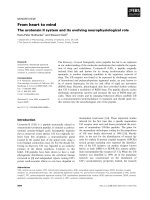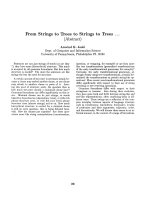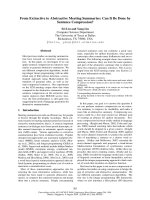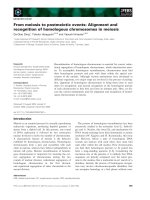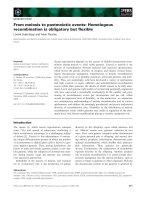Báo cáo y học: "From sequence to structure to networks" pps
Bạn đang xem bản rút gọn của tài liệu. Xem và tải ngay bản đầy đủ của tài liệu tại đây (50.12 KB, 3 trang )
Genome
BBiioollooggyy
2008,
99::
326
Meeting report
FFrroomm sseeqquueennccee ttoo ssttrruuccttuurree ttoo nneettwwoorrkkss
Nir Yosef* and Lukas Käll
†
Addresses: *School of Computer Science, Tel Aviv University, Tel Aviv 69978, Israel.
†
Center for Biomembrane Research, Department of
Biochemistry and Biophysics, Stockholms Universitet, Stockholm, Sweden.
Correspondence: Lukas Käll. Email:
Published: 4 November 2008
Genome
BBiioollooggyy
2008,
99::
326 (doi:10.1186/gb-2008-9-11-326)
The electronic version of this article is the complete one and can be
found online at />© 2008 BioMed Central Ltd
A report on the 7th European Conference on Computa-
tional Biology (ECCB), Cagliari, Italy, 22-26 September 2008.
The diversity of modern biology and the increasing interest
of the computer-science community in the field provide the
computational biologist with a wide selection of research
topics to choose from. This was well reflected at the recent
European Conference on Computational Biology in
Cagliari. Topics ranged from sequences and structures to
systems biology and phylogeny, from DNA to mRNA to
proteins. Abstracts of the meeting are published in
Bioinformatics (15 August 2008) and are freely available
online at [ />vol24/issue16/index.dtl]. Here we focus on three cherry-
picked areas: algorithms for next-generation sequencing,
structural bioinformatics and systems biology.
AAddaappttiinngg sseeqquueennccee aannaallyyssiiss mmeetthhooddss ttoo nneeww
sseeqquueenncciinngg tteecchhnnoollooggiieess
The recent development of so-called next-generation sequen-
cing - that is, massively parallel DNA/RNA sequencing
technology - was primarily motivated by the immense cost of
genome sequencing, and promises to reduce this cost by
orders of magnitude relative to traditional Sanger sequen-
cing. These new technologies do, however, have certain
shortcomings. The most striking is the significantly shorter
sequence read lengths, which call for new or adapted
computational methods for sequence analysis. Daniel Dalevi
(Lawrence Berkley National Laboratory, Berkeley, USA)
talked about annotation of such short sequence reads in
metagenome datasets generated by the 454 Life Sciences
pyrosequencing platform. He compared a number of
methods for estimating the abundance of protein families
and the existence of different taxa in a given microbial
community. Using simulated metagenome datasets as a
benchmark, he argued that replacing a short sequence read
with a full-length protein or set of proteins that have high
local similarity with the short read (the so called ‘proxygene’
or ‘proxygene cluster’) leads to improved identification of
the functional and taxonomic content of the community.
Fabio de Bona (Friedrich Miescher Laboratory, Max Planck
Society, Tübingen, Germany) presented an extension to the
well known Smith-Waterman alignment algorithm, adjusted
for short sequence reads. The algorithm, dubbed QPALMA,
incorporates information about the read quality as well as
splice-site prediction and an intron model. A support vector
machine classifier was trained to optimally weight the
different types of information. The algorithm was
benchmarked on a large set of Arabidopsis thaliana reads
from an Illumina Genome Analyzer, and a dramatic reduc-
tion in the error rate was found when information on read
quality, intron length and splice-site prediction was included.
CCoommppuuttaattiioonnaall iinnssiigghhttss iinnttoo pprrootteeiinn ssttrruuccttuurreess
One of the challenges of structural bioinformatics is to
predict the function of a protein given its structure. This is
most efficiently done when we can infer function from
homologous structures with known function. One of the
most widely used ways to detect structural homology is
protein structure alignment. This has classically been done
by measuring atom distances in rigid-body superimposition
of the compared structures; however, methods allowing
some structural flexibility were recently shown to be more
accurate in picking up distant homologies. Gergely Csaba
(Ludwig-Maximilians-University, Munich, Germany) presented
what he called a phenotypic plasticity method (PPM) for
structure alignments that borrows a couple of concepts from
sequence alignments. Like sequence alignments that
estimate the evolutionary cost of altering one sequence into
the other sequence by mutations, insertions and deletions,
PPM tries to estimate the cost of altering one structure into
the structure being compared. The ability to detect distant
homologies on a test set of some 5,000 protein domains was
better than with existing structure alignment methods.
A popular experimental technique for detecting functionally
relevant residues is to test whether the function of the
protein is altered by replacement of the selected residue with
alanine (alanine scans). Yana Bromberg (Columbia University,
New York, USA) argued that this could be done in silico
using an artificial neural network, SNAP, which is aimed at
detecting functional changes due to single-position muta-
tions. The prediction method was benchmarked on a curated
set of experimental alanine scans to cover about two-thirds
of all residues that alter the protein’s function while allowing
one-third of the predictions to be false. Bromberg also
reported that single-residue replacement with alanine is,
according to her in silico method, as informative as the
average result of sequential replacement of the residue with
the other possible amino acids.
An alternative approach to inferring protein function is to
try to predict its interaction partners. Rafael Najmanovich
(European Bioinformatics Institute, Hinxton, UK) discussed
the importance of knowing the location of the binding site
when discriminating between different potential ligands.
The presented algorithm, IsoCleft, aims at discriminating
between potential ligands using a graph-matching approach.
When the exact location of the binding site is given, the
method is (expectedly) reasonably accurate. Unfortunately,
the performance of the approach drops off quickly when
uncertainty about binding-site location is artificially intro-
duced. But if information about the geometry of the cleft
surrounding the binding site is included in the model, then
this drop in accuracy is significantly reduced. Najomanovich
therefore reasoned that, even though information about the
geometry of the cleft does not help in discriminating cases
where we know the exact location of the binding site, such
information will help when we have less detailed infor-
mation about the location of the binding site. Maybe the
most surprising conclusion from the study is that including
highly conserved cleft atoms does not seem to contribute
more than non-conserved cleft atoms to the overall perfor-
mance of the algorithm. Najmanovich explained that atoms
might be conserved for reasons other than satisfying the
constraints posed by the ligand. The topic of inferring
protein function by predicting interaction partners leads us
to our third area of focus.
FFrroomm iinntteerraaccttiioonnss ttoo nneettwwoorrkkss
A holistic perspective on the analysis of biological systems -
the systems-biology approach - is now one of the most
popular fields in computational biology. Researchers in this
field observe proteins and genes as parts of interacting sets
and make extensive use of data on physical protein-protein
interactions, transcriptional regulatory interactions, enzyme-
substrate relations and more. In addition to the ISOclef
method, described above, several other talks were dedicated
to elucidating interactions of various types between proteins
or genes.
Chia-Ying Yang (National Taiwan University, Taipei, Taiwan)
presented the PhosphoPoint database of phosphorylation in
humans. This database integrates protein kinases and phos-
phorylation sites with a large collection of protein-protein
interactions, aiming to provide researchers with a compre-
hensive repository of information on the human kinome.
Yang and colleagues also utilized gene-expression profiles
and similarities in gene ontology (GO) annotation to high-
light over 180 new potential kinase-substrate pairs, which
are available as part of the database. The relation between
GO similarity and the interactions between proteins or
protein domains was also discussed by Jayesh Pandey
(Purdue University, West Lafayette, USA), who described a
new method for measuring functional similarity using GO
annotations and investigated how this similarity is
correlated with topological proximity in protein-protein and
domain-domain interaction networks. His new scoring
method explicitly accounts for the specificity of the com-
pared annotations (rather than considering only their common
ancestor in the ontology) and for multiple annotations
(rather than simply taking the average or maximum), and
produced improved results for both proteins and domains.
Transcriptional regulatory interactions also received their
share of attention. Tristan Mary-Huard (UMR AgroParisTech/
INRA, Paris, France) described a way of efficiently identi-
fying these interactions using data from chromatin immuno-
precipitation/DNA microarray (ChIP-chip) experiments. He
argued that a two-component mixture model could be used,
where one component is fitted to the distribution of micro-
array signal from immunoprecipitated transcription factor
binding sites and one component to the signal from other
regions. This achieves better discrimination between binding
and non-binding sites as well as better statistical measures
than existing methods.
Fantine Mordelet (Ecole des Mines de Paris, France)
presented a method for predicting transcriptional regulatory
interactions from gene-expression data. The bioinformatics
literature includes a large number of methods for trans-
cription network inference based on correlations in expres-
sion, including Bayesian networks, methods based on infor-
mation theory, and more. Surprisingly, as Mordelet explained,
none of these seem to have employed supervised learning -
that is, used the increasing amount of data from experi-
mentally verified interactions. Using a set of validated
transcriptional regulatory interactions from Escherichia coli
in conjunction with a large compendium of gene-expression
data, Mordelet has constructed a supervised model (using
support vector machines) that predicts regulation on the basis
of similarity in gene-expression profiles. The main assumption
/>Genome
BBiioollooggyy
2008, Volume 9, Issue 11, Article 326 Yosef and Käll 326.2
Genome
BBiioollooggyy
2008,
99::
326
of her method is that the transcription factor of interest has at
least a few known direct targets. On the one hand, this is quite
a limiting assumption, which prohibits the analysis of new
transcription factors. On the other hand, where some of the
targets of the transcription factor are known, the method gives
a most impressive improvement in accuracy.
Gene-expression data, be they time series or compendia of
various experiments, are often used for modeling and
understanding the logical structure and/or the dynamics of
gene regulatory networks. One key problem in inferring such
systems is to correctly account for latent variables (that is,
components that are controlled outside of the subsystem
being modeled and that are often not directly measurable).
Neil Lawrence (University of Manchester, UK) described a
method for inferring transcription factor activity, which is
typically very hard to discern experimentally, by repre-
senting the activity as a latent variable in a dynamic model of
the expression of the factor’s downstream genes. The
method uses Gaussian processes to define priors over the
time-continuous activity of the transcription factor, and a set
of differential equations (linear and nonlinear) to model its
effects on gene expression. The parameters of this probabi-
listic model are fitted according to the observed time-series
of mRNA concentrations, and were then used to estimate the
unobserved activities of a number of transcription factors,
including P53 (humans), and LexA (E. coli).
Although biochemical network models of this kind are often
very comprehensive, they are confined to a small scale,
primarily because of the lack of sufficient data. Aitor
González (Kyoto University, Japan) described such a fine-
grained model of the logic of the Hedgehog (Hh) signaling
pathway in Drosophila melanogaster and its role in wing
development. The model was constructed manually and
comprises seven genes and four cell types. Interactions
between genes were collected from the literature and trans-
lated into a set of logical rules describing the effect of one
gene on the activity of the others. Through simulations of the
dynamics under various perturbation regimes, this model
was shown to provide novel insights regarding several, less
understood, aspects of this system.
Invigorating poster sessions, talks and keynote speeches at
the meeting covered many perspectives in the growing
discipline of computational biology. We look forward to the
next ECCB meeting, which will be co-located with Intelligent
Systems for Molecular Biology (ISMB) in Stockholm in 2009.
/>Genome
BBiioollooggyy
2008, Volume 9, Issue 11, Article 326 Yosef and Käll 326.3
Genome
BBiioollooggyy
2008,
99::
326
